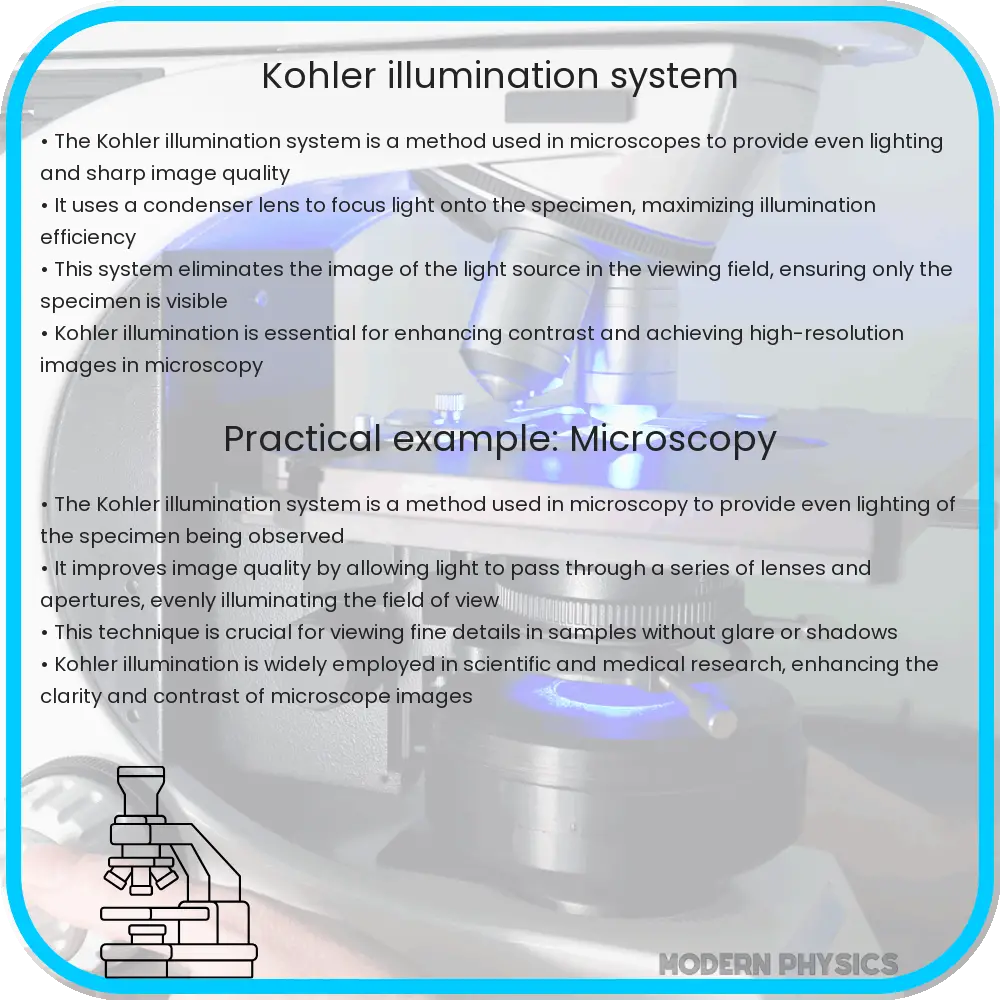Explore the Kohler Illumination System: enhancing microscope clarity, uniformity, and precision with advanced optical techniques for superior imaging.

The Kohler Illumination System: Enhancing Microscopy with Uniformity, Clarity, and Precision Optics
The Kohler Illumination System is a pivotal advancement in the realm of optical microscopy, designed to optimize the illumination of the specimen field for enhanced observation and imaging. Developed by August Köhler in the early 20th century, this technique revolutionizes the way light is directed through the sample, ensuring uniform, clear, and precise visualization. This article delves into the core principles of the Kohler Illumination System, its benefits, and its critical role in modern microscopy.
Principles of Kohler Illumination
Kohler Illumination is built on the foundation of achieving even illumination across the entire field of view, which is essential for high-quality microscopic analysis. The system aligns the light path using a series of lenses and diaphragms to evenly distribute light over the specimen. This alignment ensures that each point on the specimen is illuminated by a separate set of rays, significantly reducing glare and enhancing contrast. The process involves four key components: the light source, condenser, aperture diaphragm, and field diaphragm. Together, they work to create a uniformly lit, diffraction-limited image with minimal aberrations.
Benefits of Kohler Illumination
- Uniform Illumination: By distributing light evenly across the specimen, Kohler Illumination ensures that all areas of the field of view are equally bright, eliminating hot spots and shadows for better visualization.
- Enhanced Clarity and Contrast: The system’s precise control over light direction and intensity improves the clarity and contrast of images, making it easier to distinguish fine details and subtle differences in specimens.
- Optimized for Digital Imaging: Kohler Illumination’s uniform light distribution is ideal for digital imaging applications, providing consistent illumination that enhances the quality of photographs and digital captures.
- Extended Bulb Life: By efficiently using light and minimizing the need for excessive brightness, the Kohler system helps prolong the life of microscope illumination bulbs.
The implementation of Kohler Illumination in microscopy represents a significant leap towards achieving the highest possible quality in specimen observation and analysis. Its principles of uniformity, clarity, and precision continue to set the standard for optical performance, making it an indispensable tool in the advancement of scientific research and medical diagnostics.
Understanding the Kohler Illumination System
The Kohler Illumination System represents a significant advancement in optical microscopy, offering enhanced uniformity, clarity, and precision in visualizing specimens. This technique, developed by August Köhler in the early 20th century, has become a fundamental aspect of modern microscopy, contributing to the accuracy and quality of microscopic analysis across various scientific fields.
Principles of Kohler Illumination
At its core, the Kohler Illumination System is designed to evenly illuminate the field of view, minimizing glare and maximizing the resolution and contrast of the image. This is achieved through a series of optical adjustments that align the light path and evenly distribute light across the specimen. The system uses a condenser to focus the light on the specimen and an aperture diaphragm to control the amount of light, thereby optimizing the depth of field and contrast.
Benefits of Kohler Illumination
- Uniform Illumination: By providing even lighting across the specimen, it ensures that all areas of the field of view are equally illuminated, eliminating bright spots and shadows that can obscure details.
- Enhanced Clarity and Contrast: The precise control over the light path allows for improved clarity and contrast, making it easier to distinguish between fine details and structures within the specimen.
- Improved Resolution: Kohler Illumination helps in achieving the theoretical maximum resolution of the microscope by optimizing the conditions under which light interacts with the specimen.
Implementation and Adjustments
Setting up Kohler Illumination involves adjusting the condenser height, centering the light source, and fine-tuning the aperture diaphragm. These adjustments are crucial for achieving the desired optical conditions and require some practice to master. However, the effort is well rewarded by the significant improvements in image quality.
Conclusion
The Kohler Illumination System is a cornerstone of modern optical microscopy, providing scientists and researchers with a powerful tool for observing specimens with unparalleled clarity, contrast, and resolution. Its principles of uniform light distribution and precise optical adjustments have set a standard in microscopy that ensures accurate and detailed observations. Whether for research, diagnostic purposes, or educational applications, the Kohler Illumination System enhances our ability to see and understand the microscopic world, bridging the gap between the unseen details and our quest for knowledge.
